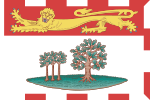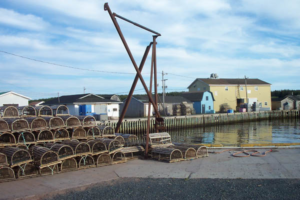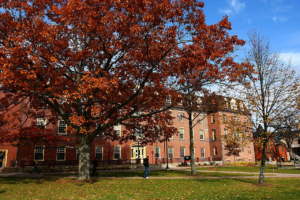
Prince Edward Island (PEI) is one of the thirteen provinces and territories of Canada. It is the smallest province in terms of land area and population, but the most densely populated. The island has several nicknames: “Garden of the Gulf”, “Birthplace of Confederation” and “Cradle of Confederation”. Its capital and largest city is Charlottetown. It is one of the three Maritime provinces and one of the four Atlantic provinces.
PEI is located in the Gulf of St. Lawrence, about 200 kilometers (120 miles) north of Halifax, Nova Scotia and 600 kilometers (370 miles) east of Quebec City, and has a land area of 5,686.03 km2 (2,195.39 sq. mi).The main island is 5,620 km2 (2,170 sq. mi) in size. It is the 104th-largest island in the world and Canada’s 23rd-largest island.
According to Statistics Canada, the province of PEI has 158,717 residents. As PEI is one of Canada’s older settlements, its population still reflects some of the earliest settlers, with Canadian, Scottish, Irish, and English surnames being dominant.
The exterior of Province House, Prince Edward Island
The climate of the island is a maritime climate considered to be moderate and strongly influenced by the surrounding seas. As such, it is milder than inland locations owing to the warm waters from the Gulf of St. Lawrence. The climate is characterized by changeable weather throughout the year; it has some of the most variable day-to-day weather in Canada, in which specific weather conditions seldom last for long.
During July and August, the average daytime high in PEI is 23 °C (73 °F); however, the temperature can sometimes exceed 30 °C (86 °F) during these months. In the winter months of January and February, the average daytime high is −3.3 °C (26 °F). The Island receives an average yearly rainfall of 855 millimeters (33.7 in) and an average yearly snowfall of 2,850 millimeters.
Winters are moderately cold and long but are milder than inland locations, with clashes of cold Arctic air and milder Atlantic air causing frequent temperature swings.
During the winter months, the island usually has many storms (which may produce rain as well as snow) and blizzards since during this time, storms originating from the North Atlantic or the Gulf of Mexico frequently pass through. Springtime temperatures typically remain cool until the sea ice has melted, usually in late April or early May. Summers are moderately warm, but rarely uncomfortable, with the daily maximum temperature only occasionally reaching as high as 30 °C (86 °F). Autumn is a pleasant season, as the moderating Gulf waters delay the onset of frost, although storm activity increases compared to the summer. There is ample precipitation throughout the year, although it is heaviest in the late autumn, early winter and mid spring.

Photo: Lobster traps at the harbor of Naufrage
The provincial economy is dominated by the seasonal industries of agriculture, tourism, and the fishery. The island also has tourists who visit year-round with tourists enjoying a variety of leisure activities, including the beaches, various golf courses, eco-tourism adventures, touring the countryside, and varied cultural events in local communities around the island. The economy of most rural communities on the island is based on small-scale agriculture. Industrial farming has increased as businesses buy and consolidate older farm properties. The province is limited in terms of heavy industry and manufacturing, though Cavendish Farms runs extensive food manufacturing operations on PEI. Agriculture remains the dominant industry in the provincial economy, as it has since colonial times.
Many of the province’s coastal communities rely upon shellfish harvesting, particularly lobster fishing as well as oyster fishing and mussel farming.
The island’s economy has grown significantly over the last decade in key areas of innovation. Aerospace, bioscience, information and communications technology, and renewable energy have been a focus for growth and diversification.

Photo: The Confederation Bridge is a fixed link between the island and the mainland
Several airlines service the Charlottetown Airport (CYYG); the Summerside Airport (CYSU) is an additional option for general aviation.
Prince Edward Island’s transportation network has traditionally revolved around its seaports of Charlottetown, Summerside, Borden, Georgetown, and Souris —linked to its railway system, and the two main airports in Charlottetown and Summerside, for communication with mainland North America.
In May 1997, the Confederation Bridge opened, connecting Borden-Carleton to Cape Jourimain, New Brunswick. The world’s longest bridge over ice-covered waters, it replaced the Marine Atlantic ferry service. Since then, the Confederation Bridge’s assured transportation link to the mainland has altered the province’s tourism and agricultural and fisheries export economies.

Photo: The SDU Main Building at the University of Prince Edward Island
Prince Edward Island’s public school system has an English school district named the Public Schools Branch (previously the English Language School Board), as well as a Francophone district, the Commission scolaire de langue française. The English language districts have a total of 10 secondary schools and 54 intermediate and elementary schools while the Francophone district has 6 schools covering all grades. 22 per cent of the student population is enrolled in French immersion. This is one of the highest levels in the country.
Three public post-secondary institutions operate in the province, including one university, and two colleges. The University of Prince Edward Island is the province’s only public university, and is located in the city of Charlottetown. The university was created by the Island legislature to replace Prince of Wales College and St. Dunstan’s University. UPEI is also home to the Atlantic Veterinary College, which offers the region’s only veterinary medicine program.
Collège de l’Île, and Holland College are two public colleges that operate in the province; the former being a French first language institution, while the latter was an English first language institution. Holland College included specialized facilities such as the Atlantic Police Academy, Marine Training Centre, and the Culinary Institute of Canada. In addition to public post-secondary institutions, Prince Edward Island is also home to a private post-secondary institutions, Maritime Christian College.
Source of the majority of Photos and Content of this page: Wikipedia
It is your duty in life to save your dream
AMEDEO MODIGLIANI